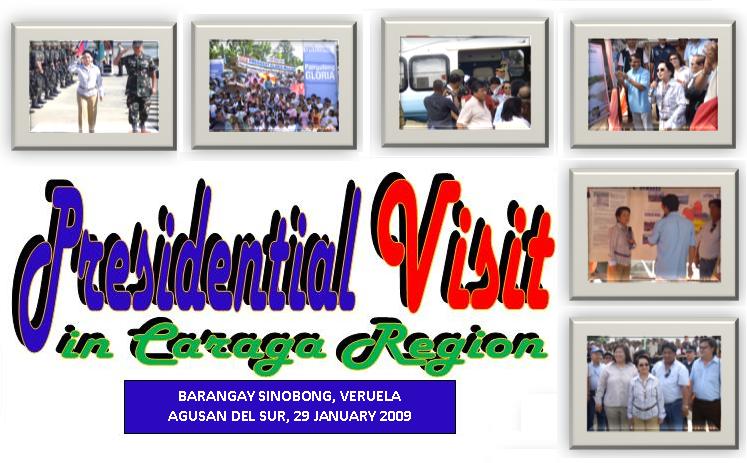
skip to main |
skip to sidebar

ARCHIVE OF EVENTS:
-
▼
2009
(10)
-
▼
February
(10)
- 1. SUMMARY OF EVENTS...
- 2. Ocular Inspection a day before the Visit...
- 3. ID Distribution to Local Media...
- 4. PGMA's Arrival in Bancasi Airport, Butuan City...
- 5. Presidential Party's Arrival in Brgy. Sinobong,...
- 6. PGMA's briefing w/ NIA-Agusan Sur Prov'l Office...
- 7. PGMA's send-off in Veruela, Agusan del Sur...
- 8. Tarpaulins installed during the Visit...
- 9. Interview with Farmer-Beneficiaries of Baobo Na...
- 10. Distribution of Bureau of Communications Servi...
-
▼
February
(10)
Presidential Seal

The presidential seal was adopted by President Manuel Roxas in 1947. The design was made by the artist Galo Ocampo, who also designed the coat of arms of the Republic.
Actually, the presidential seal is composed of the coat of arms of the President of the Philippines, surrounded by the legend “Seal of the President of the Philippines” (”Sagisag ng Pangulo ng Pilipinas”). The blue circle is the shield; on the shield is a red triangle (representing liberty, equality, and fraternity, the ideals of the French and Philippine revolutions and our republic), on which is a sealion and three stars.
The sealion is a lion with a sea creature’s tail. It was adopted as part of the coat of arms of the city of Manila during the reign of Philip II. Manila’s coat of arms was an adaptation of the arms of the Spanish kingdoms of Castile and Leon. To show we were ultramar, or a new settlement overseas, the Lion of Leon became a sealion.
The sealion became the symbol both of Manila and of the governors-general; therefore, a symbol of the supreme authority in the islands. Combined with the red triangle representing valor and the three stars representing Luzon, Visayas and Mindanao, the triangle then represents the President of the Philippines as supreme authority and successor of past rulers.
The triangle is on the Philippine sun, as adopted for our flag, with the eight rays representing the provinces placed under martial law at the onset of the revolution against Spain.During the administration of President Elpidio Quirino, the American presidential seal, after which our own was patterned, was modified to include a ring of stars representing the states of the union. Quirino modified the presidential seal to include a ring of stars, representing the provinces of the Philippines, then 52.
Because of poor terminology in the official document specifying the seal, and ignorance of heraldry on the part of officials, the stars were represented as white stars, although the Executive Order specified they would be gold. This was because people were more familiar with the American design.
During President Estrada’s term, the presidential seal was further modified to reflect the great increase in the number of provinces since 1952. Now, we have 79. To correct the errors that are possible due to sloppy terminology, President Gloria Macapagal Arroyo signed Executive Order 310 recently, correcting the lapses in terminology and representations that have crept in over the years.
The result is a superior rendering of the presidential coat of arms and seal.
Actually, the presidential seal is composed of the coat of arms of the President of the Philippines, surrounded by the legend “Seal of the President of the Philippines” (”Sagisag ng Pangulo ng Pilipinas”). The blue circle is the shield; on the shield is a red triangle (representing liberty, equality, and fraternity, the ideals of the French and Philippine revolutions and our republic), on which is a sealion and three stars.
The sealion is a lion with a sea creature’s tail. It was adopted as part of the coat of arms of the city of Manila during the reign of Philip II. Manila’s coat of arms was an adaptation of the arms of the Spanish kingdoms of Castile and Leon. To show we were ultramar, or a new settlement overseas, the Lion of Leon became a sealion.
The sealion became the symbol both of Manila and of the governors-general; therefore, a symbol of the supreme authority in the islands. Combined with the red triangle representing valor and the three stars representing Luzon, Visayas and Mindanao, the triangle then represents the President of the Philippines as supreme authority and successor of past rulers.
The triangle is on the Philippine sun, as adopted for our flag, with the eight rays representing the provinces placed under martial law at the onset of the revolution against Spain.During the administration of President Elpidio Quirino, the American presidential seal, after which our own was patterned, was modified to include a ring of stars representing the states of the union. Quirino modified the presidential seal to include a ring of stars, representing the provinces of the Philippines, then 52.
Because of poor terminology in the official document specifying the seal, and ignorance of heraldry on the part of officials, the stars were represented as white stars, although the Executive Order specified they would be gold. This was because people were more familiar with the American design.
During President Estrada’s term, the presidential seal was further modified to reflect the great increase in the number of provinces since 1952. Now, we have 79. To correct the errors that are possible due to sloppy terminology, President Gloria Macapagal Arroyo signed Executive Order 310 recently, correcting the lapses in terminology and representations that have crept in over the years.
The result is a superior rendering of the presidential coat of arms and seal.


